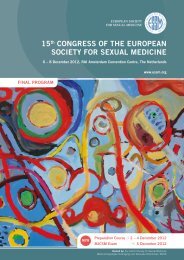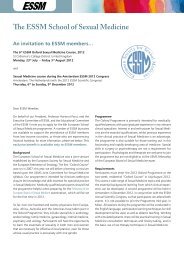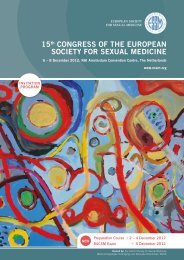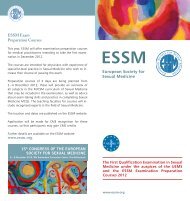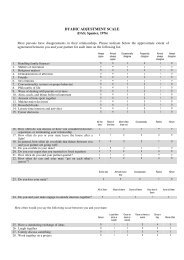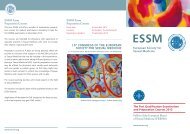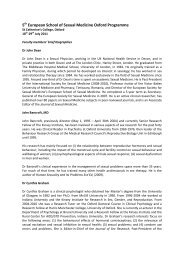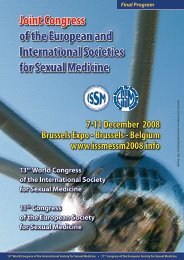FINAL PROGRAM www.essm.org 10th Congress of the European ...
FINAL PROGRAM www.essm.org 10th Congress of the European ...
FINAL PROGRAM www.essm.org 10th Congress of the European ...
- No tags were found...
Create successful ePaper yourself
Turn your PDF publications into a flip-book with our unique Google optimized e-Paper software.
general informationPortugalPortugal has a rich seafaring past, superb beachresorts, wistful towns and a landscape wrea<strong>the</strong>d inolive groves, vineyards and wheat fields. Littered withUNESCO World Heritage sites and graced by one <strong>of</strong>Europe’s most relaxed and attractive capitals, it alsoremains refreshingly affordable.Portugal lies immediately west <strong>of</strong> Spain, and is buffetedalong its sou<strong>the</strong>rn coast by <strong>the</strong> Atlantic Ocean.To its west and southwest lie <strong>the</strong> islands <strong>of</strong> <strong>the</strong> Azoresand Madeira, far out in <strong>the</strong> Atlantic. It measures just560km north to south and a paltry 220km from eastto west. The nor<strong>the</strong>rn and central regions are heavilypopulated and characterised by rivers, valleys, forestsand mountains - <strong>the</strong> highest range is <strong>the</strong> Serra daEstrela, peaking at Torre (1993m). The south is lesspopulated and, apart from <strong>the</strong> rocky backdrop <strong>of</strong> <strong>the</strong>Algarve, much flatter and drier.In <strong>the</strong> 15th century Portugal entered a phase <strong>of</strong> overseasexpansion due to <strong>the</strong> efforts <strong>of</strong> Prince Henry<strong>the</strong> Navigator. Mariners set <strong>of</strong>f to discover new traderoutes and helped create an enormous empire that,at its peak, extended to India, <strong>the</strong> Far East, Brazil andAfrica. This period marked <strong>the</strong> apogee <strong>of</strong> Portuguesepower and wealth, but it faded towards <strong>the</strong> end <strong>of</strong><strong>the</strong> 16th century. In 1755 Lisbon has been destroyedby three major earthquakes, tremors, a fire and a tidalwave. At <strong>the</strong> close <strong>of</strong> <strong>the</strong> 18th century, Napoleon sentexpeditionary forces to invade Portugal but <strong>the</strong>y wereforced back by <strong>the</strong> troops <strong>of</strong> <strong>the</strong> Anglo-Portuguese alliance.During <strong>the</strong> 19th century <strong>the</strong> economy falteredand republicanism took hold. National turmoil led to<strong>the</strong> abolition <strong>of</strong> <strong>the</strong> monarchy in 1910 and <strong>the</strong> founding<strong>of</strong> a democratic republic. Nowadays savouringlife slowly is a Portuguese passion, and much <strong>of</strong> <strong>the</strong>best is humble - traditional folk festivals; honest foodsimply dressed in olive oil; music that pulls at <strong>the</strong> heartstrings, recalling past love and glories; and marketsoverflowing with fish, fruit and flowers.At its heart are wide, tree-lined avenues graced byArt Nouveau buildings, mosaic pavements and streetcafes. Seen from <strong>the</strong> river - one <strong>of</strong> <strong>the</strong> city’s manygreat viewpoints - Lisbon is an impressionist picture<strong>of</strong> low-rise ochre and pastel, punctuated by churchtowers and domes.Lisbon is <strong>the</strong> kind <strong>of</strong> place where you can sit at streetcafes - sampling food or fado - and watch <strong>the</strong> worldgo by. For <strong>the</strong> eager <strong>the</strong>re are also plenty <strong>of</strong> culturalactivities. In addition to architectural masterpieces atBelém, Lisbon has over 50 museums to visit.The Torre Belem, a hexagonal chess piece, symbolisesPortugal’s glorious triumphs in <strong>the</strong> Age <strong>of</strong> Discoveries:it was from Belém that Vasco da Gama set sail for <strong>the</strong>New World. Designed by <strong>the</strong> brilliant Arruda bro<strong>the</strong>rs,Diogo and Francisco, <strong>the</strong> tower is a shakennot-stirredmix <strong>of</strong> early Gothic, Byzantine and Manueline styles.Manuel I built it around 1515 to guard <strong>the</strong> entranceto Lisbon’s harbour, perhaps to catch invaders <strong>of</strong>fguard.Travel to Lisbon/AirportLisbon airport is <strong>the</strong> city’s main international gatewayand located in 15 km distance to <strong>the</strong> city centre andcongress venue. The taxi fare from <strong>the</strong> airport to any<strong>of</strong> <strong>the</strong> congress hotels and congress venue is expectedto be approximately EUR 20 and a 20-minute drive.ClimateLisbon is located in a temperate climatic zone with aCentral <strong>European</strong> climate influenced by <strong>the</strong> atlanticclimate. In November <strong>the</strong> average daytime temperatureis 15°C (63F°) and it slightly rains more than ino<strong>the</strong>r months.City <strong>of</strong> LisbonLisbon’s position on seven low hills beside a river oncelured traders and settlers, and it’s still a stunning site.Add to that its cultural diversity, laid-back feel andarchitectural time warp it represents one <strong>of</strong> <strong>the</strong> mostenjoyable cities in Europe.13




